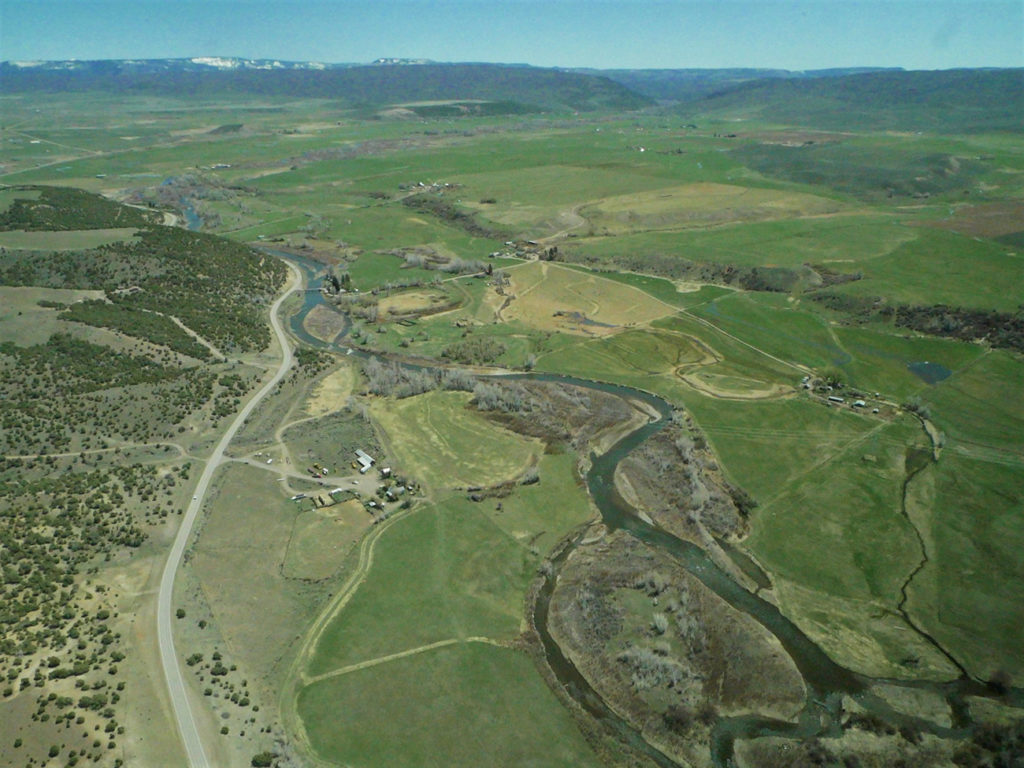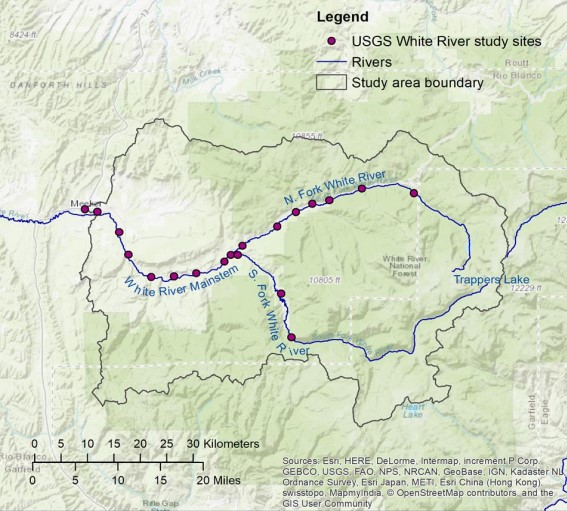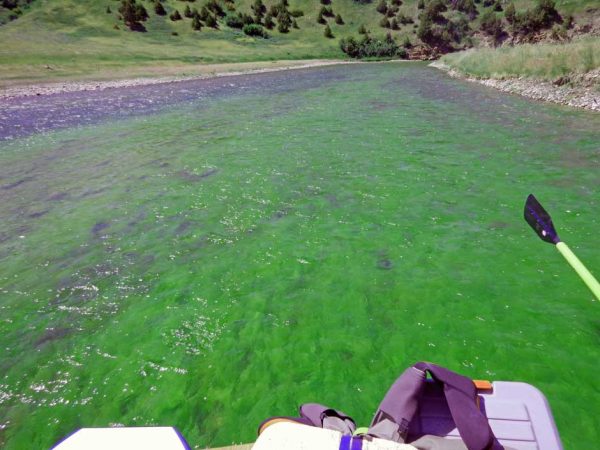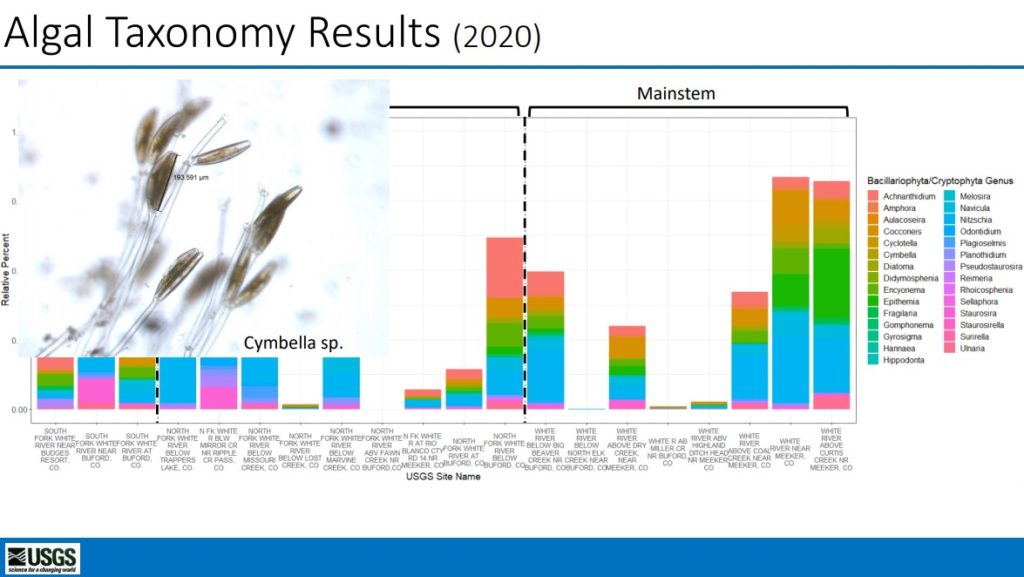Algae bloom effects cause frustration, uncertainty
RBC I This week, the HT conducted interviews with Alden VandenBrink, manager of the Rio Blanco Water Conservancy District; Bob Tobin, a former USGS hydrologist and water quality expert; Dr. Bob Dorsett, White River Alliance member; and Callie Hendrickson, White River Conservancy District Executive Director.
This is part three in an ongoing series covering the state of the White River. You can find parts one and two at https://www.theheraldtimes.com/?s=state+of+the+river.


ALDEN VANDENBRINK
“It makes life extremely hard down here,” said Alden VandenBrink, manager of the Rio Blanco Water Conservancy district, in an interview with the HT earlier this week. As someone who works directly with landowners on the lower White River, VandenBrink sees the impacts of algae blooms firsthand.
“There have been some instances where pumps have burned up, and then we lose the ability to properly irrigate, or divert water if it’s for the town of Rangely,” he said, emphasizing just how hard the algae has been on local residents over the years, particularly agricultural users. “Two years ago one rancher just threw his hands up in the air — an irrigator — and he just said, ‘I’m done, it’s not worth it for me anymore.’ That’s hard.”
The impacts of algal overgrowth on agriculture are one pillar of the broader economic and quality-of-life impacts caused by major algae blooms. The Town of Rangely, after spending more than $8 million to upgrade their water treatment system, was then immediately forced to cope with hundreds of pounds of algae clogging intake screens, forcing town employees to dedicate hours to clearing the screens multiple times every day. Recreational users, who in the past enjoyed the benefits of the river year round, have had to “hang up their rod and reels” when algae arrives, according to VandenBrink, who also pointed out that you wouldn’t want to float the river on a tube, paddleboard or anything similar during thick algae blooms. “It sticks all over you, gets all over your body, and it’s gross,” he said.
VandenBrink’s frustration and desire to address the causes of algae was evident as he recounted more stories of residents who have been severely impacted in one way or another since blooms first started in 2014. “Something triggered that to happen, what it was I couldn’t tell you. But there was an event-based cause, it was not there any previous years, ever.” he said.
Although having a clear memory of the timeline of events can offer a valuable clue for identifying potential causes, Vanden Brink noted that there probably won’t be a “smoking gun” since a variety of factors are likely contributing to the problem.
Even in 2014 specifically, he noted that a possible water release from Lake Avery, construction projects in the river, fish feeding, pond return flows, land use changes related to irrigation, forest fires, and climate impacts like drought and high temperatures were all present at the time. Most if not all of these factors persist to this day, along with the algae. Unfortunately, factors like low streamflow/high temps are much more difficult to address, regardless of how they contribute to algae blooms. For this reason Vanden Brink hopes the final report from the USGS algae study will inform “best management practices.” He emphasized that better awareness for private landowners should be a key component of that effort, particularly for activities that could be adding nutrients to, or generally degrading the water quality in the river.
“We also have to get our landowners that are directly impacting our river, somehow, to understand that what they’re doing is changing how that ecosystem works,” he said, adding “something’s gotta change, because what we have here is not sustainable, nor is it right to see the additional expense we’ve got ranchers and irrigators on the lower White River system having to go through to put water on the ground.”
BOB TOBIN
“Rivers to me, they’re sort of like the arteries in the human being, they tell a lot about the health of the system,” said former USGS hydrologist and water quality expert Bob Tobin, reflecting on the current state of the White River.
Tobin has been described by other stakeholders and local experts as having one of the more well-informed perspectives on the river, historically speaking, given his prior work analyzing water quality, hydrology and other related subjects.
Tobin’s general perspective on the potential causes for algae blooms is a fairly common one amongst water quality experts. He believes “nutrient loading” (specifically of phosphorus and nitrogen) are likely playing a major role in driving algae blooms.

Map of nutrient sample sites. Samples collected in October 2020 | COURTESY PHOTO
“I’ve worked on streams in both California and Ohio, and here in Colorado, and I can tell you that once nutrients reach a certain level in these river systems, unless there’s something in there’s that’s controlling [it], under normal circumstances you will start to get algae blooms,” he said.
Nutrient loading in rivers above a certain amount can upset a delicate balance, and so they’re oft-cited as one of the primary causes of algae blooms. Unfortunately, finding and identifying the source of nutrients is not always as straightforward as it might seem. Tobin told the HT that a variety of factors can influence even the most rigorous studies, such as sampling methodology, varying kinds of nutrients in the category of “nitrogen” (like nitrite, ammonia and organic nitrogen,) and specific methods of analysis that can lead to skewed results. Despite these challenges, however, Tobin reiterated that nutrients, in his opinion, “seem to be a major player.”
Adding to this view are the opinions of experts studying similar algae blooms in other parts of the country. Montana’s Gallatin River is an example of a river that has seen severe filamentous green algae blooms since at least 2018. Sampling and analysis of the Gallatin revealed the river contained unnaturally high levels of manmade nutrients, particularly nitrogen. In response, community members including riverfront landowners in the Gallatin basin initiated efforts to work towards restoring the health of their river:
• Education/outreach efforts to landowners along the river about leaky/damaged/old septic systems and how to fix them, along with information on not flushing certain waste products, strategies for conserving water etc.
• Examining major nutrient sources and developing strategies to mitigate them in a way that worked for landowners and the health of the river
• Geo-engineering work along de-vegetated streambanks to restore the natural “filter” created by vegetation, which keeps more nutrient rich runoff out of the river system

Montana’s Smith River covered in Algae | Montana DEQ PHOTO
• Creation of a centralized water treatment system to consolidate waste from formerly isolated septic systems along the river
“Anytime humans inhabit a river basin, they are gonna have impacts on it,” noted Tobin, pointing out that given significant development along the upper White River in the last several decades, he’s “not surprised that there are algae blooms going on.”
Montana’s Smith River has also seen algae blooms for at least the last 5-6 years, and though studies are ongoing, work to identify the cause has primarily focused on nutrient loads, with scientists collecting samples from dozens of sites over the last two years to get a clearer picture of where nutrients may be coming from. Scientists noted that nutrients can come from both manmade and natural causes, including erosion/runoff from phosphorus-rich sediment layers laid during the last ice age which were not previously exposed.
DR. BOB DORSETT
Dr. Bob Dorsett describes the state of the river as “really worrisome” especially when discussing the subject in the context of a prolonged drought, and white river stream flows below the 25th percentile, which has been going on a year now. He pointed out that “if the flows were normal, all these factors wouldn’t make a lot of difference.”
Dorsett emphasized that however significant nutrient loads are in triggering the algae overgrowth problem, the blooms are most likely also heavily influenced by the low streamflows, which he noted are a secondary effect of increasing temperatures. Shallower water means more sunlight reaches the streambed, allowing for increased photosynthesis in algae.
In a similar vein, spring runoff has also been examined as a strong factor in blooms, as high-flow runoff events create a “tumbling” effect that sends rocks down the river, which can scrape off algae from the prior year. For this reason low flows can have a significant detrimental impact on the season’s algae bloom as fewer rocks are “tumbled” and less “scraping” takes place on the streambed. Dorsett confirmed that this phenomenon, applied to structures in the river that impede or slow down flow velocity could have a similar effect in reducing the amount of algae that gets naturally scraped from the streambed.
Dorsett spoke to the urgency of the issue, stating that “algae blooms are not unheard of in the historical past” but the persistence of blooms for more than five years now could be having cumulative impacts. “Algae can suffocate everything else in the river” he said, noting one unique change in this year’s algae bloom is large amounts of sediment coming down the water column, which he said was “smothering” macroinvertebrate populations.
On the subject of insects in the river, insecticides and related matters, Dr. Dorsett said there is some evidence that certain caddisfly species can limit algae growth, which is why insecticides like permethrin, which kill all insects, might increase the severity of blooms. He reiterated that the evidence on the subject was minimal as of yet, and said he’d like to see more rigorous analysis on the subject moving forward.
CALLIE HENDRICKSON
White River Conservancy District Executive Director Callie Hendrickson has been at the center of the algae issue since at least 2017, when more community members became involved in seeking a solution to the problem. Since then, Hendrickson and other conservation district staff secured funding for a study by USGS, organized the Technical Advisory Group (TAG) to include multiple stakeholders and entities, and facilitated public meetings about the issue. Since that time, Hendrickson’s stance on causes of algae blooms remains firmly in waiting for the USGS final report, which comes out later this year. “Many people have an opinion on what is causing the algae. No one has the data to verify their opinion. Our expectation is that the USGS study will have the data to verify any potential cause. It may be one primary thing but it is much more likely that it is a combination,” she said.
Hendrickson also pointed out “We have to remember this algae is growing in many rivers across the country so we don’t expect a specific practice in the White River to be the primary cause.“
Hendrickson also noted that high streamflows in 2019, compared to lower flows in 2018 and 2020 have offered a diverse data set for USGS scientists to work with. She also addressed the primary challenge the process has faced, which is that “we would like to know sooner than later but we have to collect multiple years’ worth of data.”
Hendrickson was unable to answer questions about the cost of the study at the time of the inquiry, noting that she’d have to check specific numbers when she was back in the office. The original estimate for cost was just over $260,000.
The final report from USGS is expected by the end of 2021 and will be made available on the White River Conservation District website, whiterivercd.com
• • •
As part of this ongoing series we will look into more of the impacts of algae blooms in western Rio Blanco county, speaking with USGS scientists, examining the extent of river hydrological changes on the upper White River, and more.
If you have any questions about this reporting, suggestions, or otherwise please email [email protected]
This reporting is partially funded by a grant from the CU Water Desk.
By LUCAS TURNER | [email protected]om





















